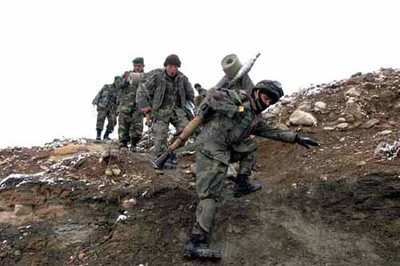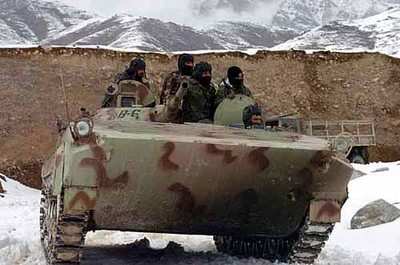Recovery Efforts Continue
The crash of a Kam Air Boeing 737 passenger jet on Feb. 4 was
believed to be Afghanistan's worst air disaster.
The International Security Assistance Force made numerous
unsuccessful rescue attempts by helicopter. But when technology
failed, the Afghan National Army responded with boots on the
ground.

Following the crash of the plane carrying 104 people, the
Ministry of Defense ordered the ANA's Central Corps to assemble a
team to attempt a rescue of victims presumed to be alive.
The crash site was at an altitude of 11,000 feet on the peak of
the Chaperi Mountain, 20 miles east of the Afghan capital of
Kabul.
The ANA's mission was to reach the summit to locate survivors
via the opposite side of Chaperi from where the crash site
occurred.
At Pol-e-Charkhi, where the ANA's Central Corps soldiers are
based, Lt. Col. Kabuly Qadeer, commander of 2nd Kandak (Battalion),
3rd Brigade quickly gathered his soldiers, who mounted their
vehicles and prepared to head to the Chenari Village at the base of
the mountain.
Alongside the ANA were their US embedded tactical trainers. The
team's commander, South Carolina Army National Guard Lt. Col.
Gordon Johnson Jr., said their mission was to support the Afghan
soldiers in any situation that developed.
At the base of Chaperi Mountain, the 2nd Kandak and the US
advisers set up a command center to coordinate between ISAF and
Central Corps headquarters.
First, the ANA set up two checkpoints leading into the area to
limit the number of people around the crash site.
Next, Qadeer, a seasoned mountain fighter familiar with the
terrain, accompanied 40 of his ANA soldiers aboard a BMP-1 armored
personal carrier. Along with them was a local village elder to use
as a guide in a rescue attempt.
The team departed the base camp around 1300 on Feb. 6. The ANA
soldiers, without any type of special climbing gear, were able to
reach halfway up the mountain by dusk in the difficult weather. But
they had to halt operations due to a snowstorm, but were able to
find a cave to hunker down in for the night.
Qadeer returned with half of the soldiers on the BMP-1 back down
the mountain to give a situation report to the command center and
to collect more supplies. Meanwhile, the soldiers who remained
behind burned two of their sleeping bags to generate heat. They
said once they got the cave warm, body heat kept them
comfortable.
Back at the command center Qadeer and Johnson discussed how the
first attempt to ascend the mountain was going.
"The climb is going good, and we had to stop because of the
snow," Qadeer said optimistically. "I will get my men some more
equipment and supplies and head out again in the morning." Johnson
gave Qadeer an update from ISAF, which was planning to fly a
Slovenian mountain rescue team onto the mountain.

The two of them, along with other 2nd Kandak staff, reviewed the
plan for Feb. 7. "The eyes of the world are watching the ANA on
this mission," Johnson said. "And the army is showing the Afghan
people that they are able to serve them in many situations."
Packed and ready to go, the team departed the base camp. At 7
a.m., the ANA soldiers were off again with fresh clothes, carrying
extra food and water.
The team was able to reach an area of the summit within five
hours and rejoin its other half, which had continued its mission
the same morning.
"I am really impressed with these guys. The way they persevered
up the mountain without special climbing gear is remarkable, and
they are getting the job done," according to US adviser South
Carolina Army National Guard Capt. Benjamin Dunn.
The soldiers began to continually probe the snow with climbing
sticks in hopes of finding some remnants of the wreckage. Because
the snow was over chest high and the ANA was not equipped with any
type of global positioning devices, locating the main crash site
was difficult.
In the meantime, ISAF got an aircraft up to the site that
morning with a team of Slovenian mountain rescue members, who
located the site and determined that no one had survived the
crash.
Then, the ISAF members had to leave the mountain to avoid being
caught in the adverse conditions.
And the Afghan soldier team was within 100 meters of the crash
site when a severe storm warning was issued from the command
center. The team had hoped to spend that night on the mountain and
await medical team arrival the following morning, Feb. 8, according
to Gen. Mohammed Zahir Azimi, Ministry of Defense spokesperson.
But their commander ordered them back to base camp. As the ANA
soldiers made their way down, the weather deteriorated rapidly. But
the soldiers made it back ahead of the storm, bringing with them
valuable information. According to Johnson, "the speed and audacity
in which the ANA operated on this mission would be impressive to
any nation's army."

Determining there were no survivors, the ISAF rescue team
shifted the operation from a rescue to a recovery mission. ISAF
began Phase 2 of the operation: planning recovery. But the snow had
continued and fog covered the mountainside, hampering flying
operations.
The ANA adjusted its operation and was standing by to assist in
the recovery. It will continue to provide security to the area and
conduct checkpoint operations.
"The people of Afghanistan are proud of you," Qadeer told the
soldiers of the 2nd Kandak. "You were given a mission to deploy,
set up checkpoints, set up a command center, and climb to the crash
site to support a rescue mission. And you completed the mission. I
thank you all."
(ANN salutes Army National Guard Sgt. 1st Class Mack Davis,
assigned to the Office of Military Cooperation Afghanistan. ANN
also salutes an old friend -- Oklahoma Army National Guard Maj.
Eric Bloom, who assisted with this article.)
 ANN's Daily Aero-Term (05.19.25): Fuel Remaining
ANN's Daily Aero-Term (05.19.25): Fuel Remaining ANN's Daily Aero-Linx (05.19.25)
ANN's Daily Aero-Linx (05.19.25) Klyde Morris (05.16.25)
Klyde Morris (05.16.25) Airborne 05.19.25: Kolb v Tornados, Philippine Mars, Blackhawk Antler Theft
Airborne 05.19.25: Kolb v Tornados, Philippine Mars, Blackhawk Antler Theft Airborne-Flight Training 05.15.25: Ray Scholarship, Alto NG, Fighter Training
Airborne-Flight Training 05.15.25: Ray Scholarship, Alto NG, Fighter Training




